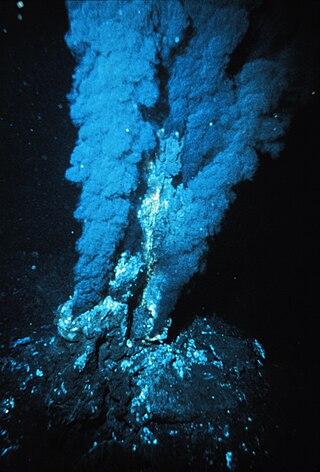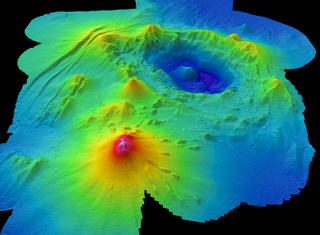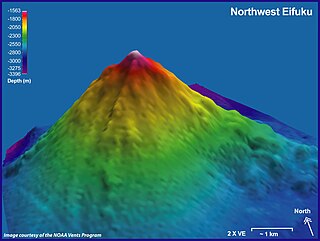
Hydrothermal vents are fissures on the seabed from which geothermally heated water discharges. They are commonly found near volcanically active places, areas where tectonic plates are moving apart at mid-ocean ridges, ocean basins, and hotspots. The dispersal of hydrothermal fluids throughout the global ocean at active vent sites creates hydrothermal plumes. Hydrothermal deposits are rocks and mineral ore deposits formed by the action of hydrothermal vents.

A cold seep is an area of the ocean floor where seepage of fluids rich in hydrogen sulfide, methane, and other hydrocarbons occurs, often in the form of a brine pool. Cold does not mean that the temperature of the seepage is lower than that of the surrounding sea water; on the contrary, its temperature is often slightly higher. The "cold" is relative to the very warm conditions of a hydrothermal vent. Cold seeps constitute a biome supporting several endemic species.

Riftia pachyptila, commonly known as the giant tube worm and less commonly known as the giant beardworm, is a marine invertebrate in the phylum Annelida related to tube worms commonly found in the intertidal and pelagic zones. R. pachyptila lives on the floor of the Pacific Ocean near hydrothermal vents. The vents provide a natural ambient temperature in their environment ranging from 2 to 30 °C, and this organism can tolerate extremely high hydrogen sulfide levels. These worms can reach a length of 3 m, and their tubular bodies have a diameter of 4 cm (1.6 in).

Alvinocarididae is a family of shrimp, originally described by M. L. Christoffersen in 1986 from samples collected by DSV Alvin, from which they derive their name. Shrimp of the family Alvinocarididae generally inhabit deep sea hydrothermal vent regions, and hydrocarbon cold seep environments. Carotenoid pigment has been found in their bodies. The family Alvinocarididae comprises 7 extant genera.

The Endeavour Hydrothermal Vents are a group of hydrothermal vents in the north-eastern Pacific Ocean, located 260 kilometres (160 mi) southwest of Vancouver Island, British Columbia, Canada. The vent field lies 2,250 metres (7,380 ft) below sea level on the northern Endeavour segment of the Juan de Fuca Ridge. In 1982, dredged sulfide samples were recovered from the area covered in small tube worms and prompted a return to the vent field in August 1984, where the active vent field was confirmed by HOV Alvin on leg 10 of cruise AII-112.

Gigantidas is a genus of large, deepwater, hydrothermal vent mussels, marine bivalve molluscs in the family Mytilidae.
Gigantidas gladius is a species of large, deepwater, hydrothermal vent mussel, a marine bivalve mollusc in the family Mytilidae, or mussels.

The hydrothermal vents and seamounts of the Azores are a series of Atlantic seamounts and hydrothermal vents that are part of the Mid-Atlantic Ridge system, giving rise to the archipelago and bathymetric region of the Azores. These geological structures, formed from masses of basalt, are of a geomorphological interest due to their rich deposits of ore. In addition it fosters a rich ecosystem of diverse subaquatic plant and animal life. There are food chains within this environment, for example, that are purely chemosynthetic, and do not need sunlight for photosynthesis.

Bathymodiolus is a genus of deep-sea mussels, marine bivalve molluscs in the family Mytilidae. Many of them contain intracellular chemoautotrophic bacterial symbionts.

Bathymodiolus thermophilus is a species of large, deep water mussel, a marine bivalve mollusc in the family Mytilidae, the true mussels. The species was discovered at abyssal depths when submersible vehicles such as DSV Alvin began exploring the deep ocean. It occurs on the sea bed, often in great numbers, close to hydrothermal vents where hot, sulphur-rich water wells up through the floor of the Pacific Ocean.
Calyptogena magnifica is a species of giant white clam found clustered around hydrothermal vents at abyssal depths in the Pacific Ocean.
Gigantidas coseli is a species of large, deepwater, hydrothermal vent mussel, a marine bivalve mollusc in the family Mytilidae, the mussels. This species is endemic to the waters of the Bonin Islands of Japan.

Bathymodiolus marisindicus is a species of deepwater hydrothermal vent mussel, a marine bivalve mollusk species in the family Mytilidae, the mussels. This species is found in the Indian Ocean.

Bathymodiolus platifrons, described by Hashimoto and Okutani in 1994, is a deep-sea mussel that is common in hydrothermal vents and methane seeps in the Western Pacific Ocean.
Amphritea atlantica is a gram-negative, aerobic, rod-shaped and motile bacterium from the genus of Amphritea which has been isolated from the mussel Bathymodiolus from the Logatchev hydrothermal vent field.
Pito Seamount is a seamount in the Pacific Ocean. It rises to a depth of 2,250 metres (7,380 ft) and features hydrothermal activity in the form of black smokers, which were discovered in 1993.

The hydrothermal vent microbial community includes all unicellular organisms that live and reproduce in a chemically distinct area around hydrothermal vents. These include organisms in the microbial mat, free floating cells, or bacteria in an endosymbiotic relationship with animals. Chemolithoautotrophic bacteria derive nutrients and energy from the geological activity at Hydrothermal vents to fix carbon into organic forms. Viruses are also a part of the hydrothermal vent microbial community and their influence on the microbial ecology in these ecosystems is a burgeoning field of research.

Monowai Seamount is a volcanic seamount to the north of New Zealand. It is formed by a large caldera and a volcanic cone just south-southeast from the caldera. The volcanic cone rises to depths of up to 100 metres (330 ft) but its depth varies with ongoing volcanic activity, including sector collapses and the growth of lava domes. The seamount and its volcanism were discovered after 1877, but only in 1980 was it named "Monowai" after a research ship of the same name.

Eifuku and NW Eifuku (北西永福) are two seamounts in the Pacific Ocean. The better known one is NW Eifuku, where an unusual hydrothermal vent called "Champagne" produced droplets of liquid CO
2. Both seamounts are located in the Northern Marianas and are volcanoes, part of the Izu-Bonin-Mariana Arc. NW Eifuku rises to 1,535 metres (5,036 ft) depth below sea level and is a 9 kilometres (5.6 mi) wide volcanic cone.
Yonaguni Knoll IV is a seamount in the Okinawa Trough, east of Taiwan. It lies at about 745 metres (2,444 ft) depth and formed through Quaternary volcanism that yielded dacitic and rhyolitic magmas. The seamount is hydrothermally active, with numerous sites that are colonized by mussels and other marine animals. A submarine underground "lake" of liquid carbon dioxide has been identified at Yonaguni Knoll IV.













